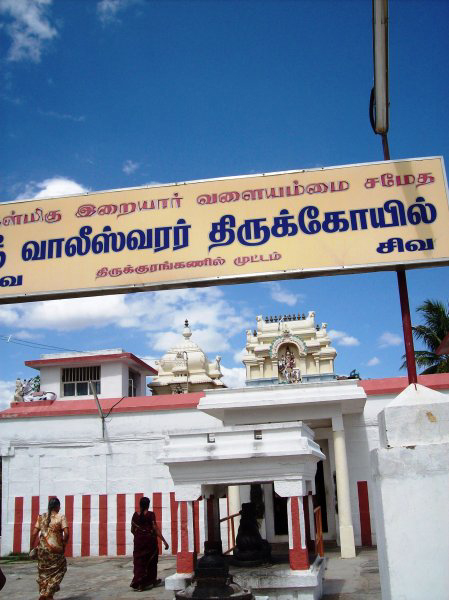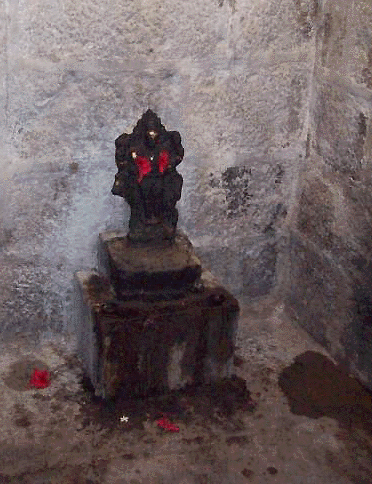
|
|
|
|
Because Lord Brahma worshipped Shiva at this place, the temple was originally called Thiruilanathai, and Shiva was known as Koyyamalainathar ('natha' referring to Brahma).
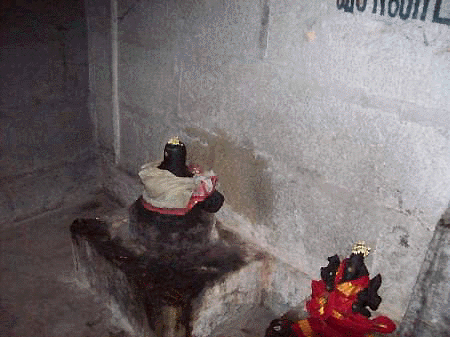
Sri Koyyamalainathar and Iraiyaar Valaiyammai The presiding deities here are Shiva Koyyamalainathar (Koyyaa Malareesar), or Vaaleeswarar, and his ambal (consort) Iraiyaar Valaiyammai. Koyyamalainathar is also known as Aramvalartha Eswarar. Valeeswarar is swayambu linga (self-manifesting). His consort is seated on a separate shrine. Lord Brahma is worshipped here as a subsidiary deity.
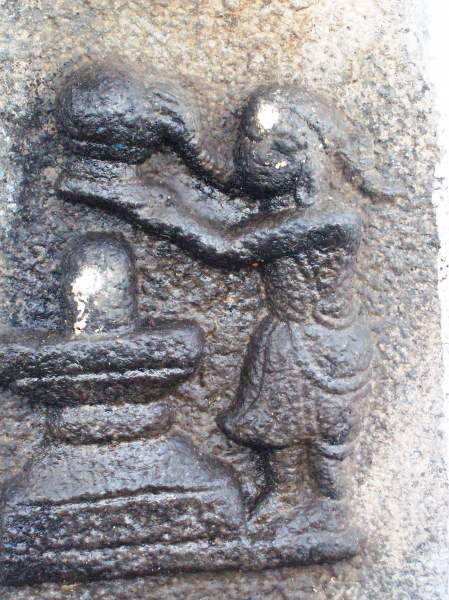
Lord Indra's linga-pooja The temple is associated with a very interesting pastime wherein Vaali the monkey (kurangu) worshipped Shiva at the entrance to the temple, while simultaneously Indra in the form of a squirrel (anil) offered worship from the south, and Emadharmaraja (Yamaraja) in the form of a crow (muttam, kaakam) offered worship from the north. This is reflected in the name, 'Kurang-anil-muttam'. Hanuman is also said to have worshipped Shiva here, and various panels depicting these pastimes are found in the temple.
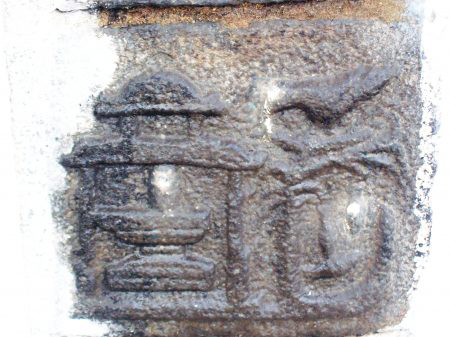
Lord Yama's linga-pooja (as crow) The temple's sanctum sanctorum is quite small, facing west, with an entrance from the south. Devotees enter through an iron gate, onto a wide campus. There is a courtyard, and on the temple grounds are Sri Poorana Kangana Tharani Theertham, the holy tank, and Ilanthai (Elanndi) as the Kaakai Theertham, or Sthala Vriksa (holy tree).
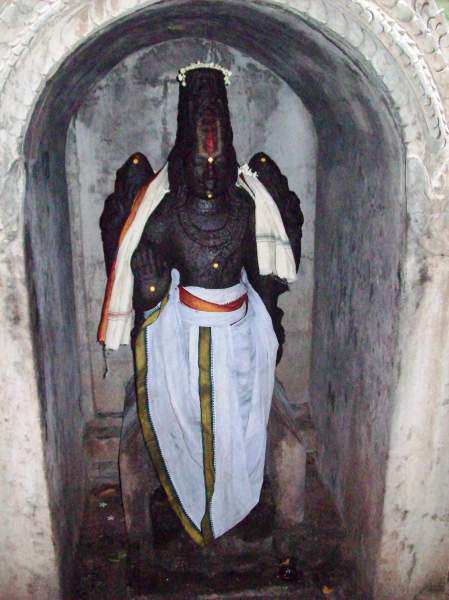
Mahavisnu There are a number of shrines in the courtyard, for Lord Brahma, Mahavishnu, Dakshinamurthi, Bairava, Durga, Sandeswarar, Varasithi Vinayakar, Manthira Ganapathy, Subramaniya with consorts Valli and Theivani, along with Surya, Candra and the Navagraha.
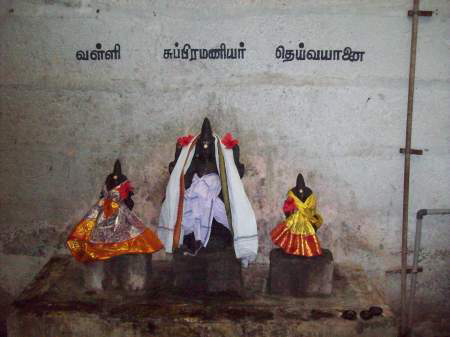
Murugan, Valli and Theivani Some renovations have recently been underway at the temple, conducted by local devotees. While not refurbished to the extent a well funded ASI project might be, the renovations accomplished by local citizens can be quite remarkable. The image below shows temple ruins that have recently been reclaimed. Some were so deteriorated that trees were growing from the temples towers.
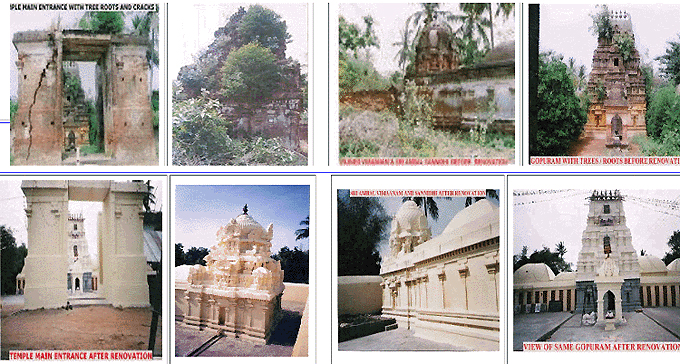
Before and after – temple renovations
The Rudravalisvaram rock-cut temple at Mamandur is another of the ancient cave temples in the area. Rudravalisvaram has three shrine cells, being a Trimurti temple. The characteristics of this type of architecture have been well described in an earlier segment), so we won't repeat them here. Suffice to say, Lord Brahma was installed as a presiding deity here, in the form of a shrine niche that may or may not have had a painted or sculpted image on the back wall at given times.
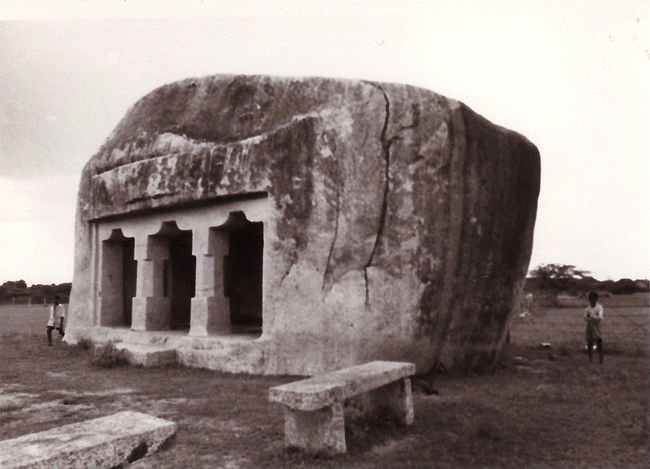
Rock-cut Temple, Mamandur Rudravalisvaram is one of two rock-cut temples excavated by Mahendra at Mamandur. It is often referred to as Rudravalisvaram (Mamandur II, a Shiva temple), while the other is called the Northern Cave Temple (Mamandur I, a Visnu temple). Being one of the oldest cave temples, Rudravalisvaram's pillars do not have the lotus medallions at top and bottom of the pillars. Mamandur is located in the Thiruvannamalai district, 12 km. north of Kanchipuram, and 4 km. from Abdullapuram.
Near the marriage hall of Kanchipuram's famed Kamakshi Amman temple is a little known site where Lord Brahma has been worshipped since the 12th century. The Kavusikesam Temple is a stone monument built by the Cholas. The temple is named Kavusikesam for the Goddess Kowsiki, who was born from the sweat of Parvati's brow. On the southern end of the main wall of the temple the word ‘Nakkarkoil’ is found, probably being an early name of the temple. Another pillar inscription belongs to the period of Kopura Kesari Varman.
The presiding deity of the temple is Kavusikeswarar, or Sokkeeswarar (Sakeeswarar) Shiva, and Lord Brahma is a subsidiary deity. We unfortunately do not have images of this temple, but Brahma is described as being situated on either side of the temple, along with two Nandis. Other deity shrines include Dakshinamurti and Yoga Nrsimhadeva.
The courtyard of the temple is in a recessed pit, which is surrounded by a wall. Along the top of the temple is a row of figures including Goddess Kowsiki, Lord Vinayaka (Ganesh) worshipping Shiva and Parvathi, along with an elephant, Khamendhenu, and peacock all offering worship. There is also a figure of Kannappar, a great devotee of Shiva, removing his eye from its socket and fitting it into the socket of the eye of Lord Shiva. In a lower row there are figures of Vinayaka and Murugan.
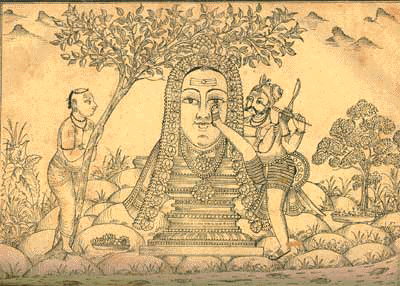
Kannapar
Our final stop in Kanchipuram is the Mahaaruthreswarar Temple, on Maadhanampalayam Street at Pillaiyar Palayam. The temple entrance is simply described as being 'door number 16' on the street. Upon entering, there is a wide hallway leading to the inner court. The presiding deity here is Mahaaruthreswarar. Lord Brahma is worshipped as a subsidiary deity. There are also separate shrines for Dakshinamurthy, Thirumaal, Durga, Sandeswarar, Bhairava, Subramanya with Valli and Theivanai, Anandha Vinayakar, and the Navagraha. In the courtyard there is an establishment of holy nagas under a Bael Tree, with a shrine nearby for Nagamman, a naga deity. There is also a Tulsi apartment behind the temple
Given the predominance of temples in Kanchipuram and throughout Tamil Nadu where Lord Brahma is worshipped as a subsidiary deity, we would like to remind the reader of an important point of clarification in this regard.
When referring to the Guna-avataras, one might technically consider Lord Brahma to be subsidiary to Lord Shiva, although more importantly, both are subordinate to the Supreme Personality of Godhead. Both Brahma and Shiva are great devotees of the Lord. In his Purport to Srimad-Bhagavatam 8:12:4, Srila Prabhupada states:
"The Supreme Personality of Godhead, Visnu, resides within the material world as the sattva-guna-avatara. Lord Siva is the tamo-guna-avatara, and Lord Brahma is the rajo-guna-avatara, but although Lord Visnu is among them, He is not in the same category. Lord Visnu is deva-deva, the chief of all the demigods. Since Lord Siva is in this material world, the energy of the Supreme Lord, Visnu, includes Lord Siva. Lord Visnu is therefore called jagad-vyapi, "the all-pervading Lord." Lord Siva is sometimes called Mahesvara, and so people think that Lord Siva is everything. But here Lord Siva addresses Lord Visnu as Jagad-isa, "the master of the universe." Lord Siva is sometimes called Visvesvara, but here he addresses Lord Visnu as Jagan-maya, indicating that even Visvesvara is under Lord Visnu's control. Lord Visnu is the master of the spiritual world, yet He controls the material world also, as stated in Bhagavad-gita (mayadhyaksena prakrtih suyate sacaracaram). Lord Brahma and Lord Siva are also sometimes called isvara, but the supreme isvara is Lord Visnu, Lord Krsna."
So when we refer to Lord Brahma as being a 'subsidiary deity' in a temple, we should keep in mind that he has been worshipped in these temples for countless years as an exalted member of the Trimurti. And for devotees in the Brahma Madhva Gaudiya Vaisnava Sampradaya, his position as Sampradaya Acarya is unparalleled. As jivatmas in this Kali yuga we, the readers, undoubtedly find ourselves in similar circumstances: we were born into mleccha families, we did not have pious births, and we are maintaining our spiritual lives based on the mercy that has been channeled through the Sampradaya from Lord Caitanya Mahaprabhu. We have become devotees due to the Lord's causeless mercy. As such, we are not in a position to relegate someone as exalted as Lord Brahma -- the head of our Sampradaya, the expounder of the Vedas, the only personality in the universe who does not have a mother, being born of the lotus flower coming from the naval of Lord Visnu. We have to be extremely careful not to commit any offenses whatsoever in this regard, especially if we consider ourselves members of his Brahma Sampradaya -- the Sampradaya that Lord Caitanya chose to Appear in and surcharge. So relegating temples to this or that position, or relegating Lord Brahma as being 'subsidiary', or lesser than Lord Shiva – such matters mean nothing to us as individuals at this particular point in our existence. The only thing that should mean anything to us, is the desire to get out of this incredibly hellish situation that we find ourselves in, and our only hope of doing that is through the causeless mercy of our Sampradaya. And particularly, of course, the latest manifestation of the Sampradaya Acaryas, who are actually connected in an unbroken chain back to Lord Brahma. This dynamic is similar in many respects to what's happening today with Srila Prabhupada. One makes a great mistake in accepting a spiritual authority who claims to be connected to our Sampradaya, but who does not properly understand Srila Prabhupada's exalted position. This is not unlike the fallen conditioned souls proposing to minimize Lord Brahma. It is playing with fire. It's far better to glorify than to minimize, especially if you are a fool.
| |
